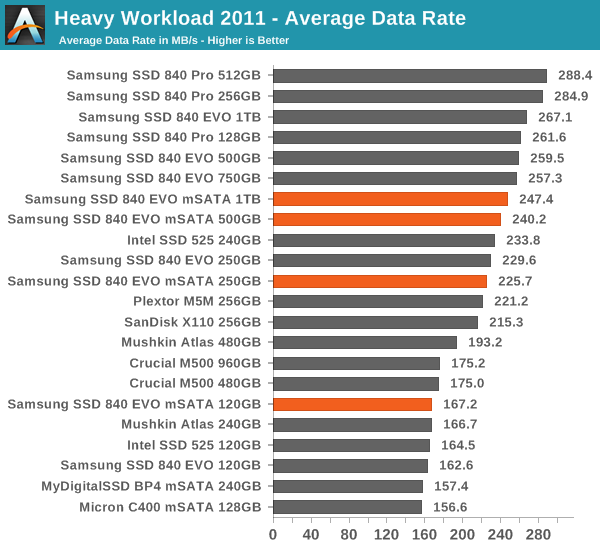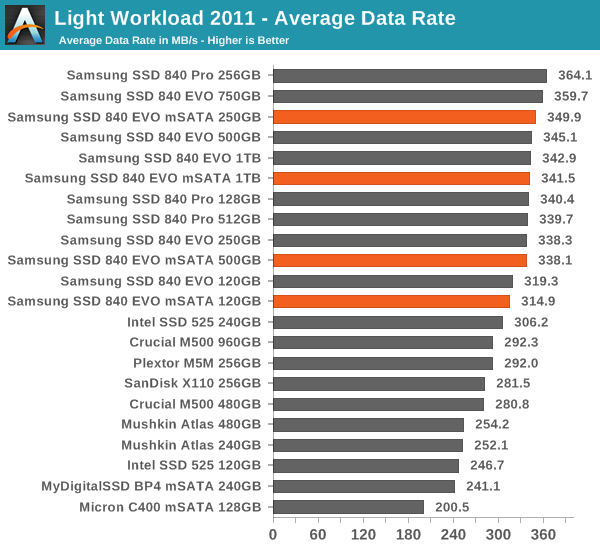Samsung SSD 840 EVO mSATA (120GB, 250GB, 500GB & 1TB) Review
by Kristian Vättö on January 9, 2014 1:35 PM ESTAnandTech Storage Bench 2011
Two years ago we introduced our AnandTech Storage Bench, a suite of benchmarks that took traces of real OS/application usage and played them back in a repeatable manner. Anand assembled the traces out of frustration with the majority of what we have today in terms of SSD benchmarks.
Although the AnandTech Storage Bench tests did a good job of characterizing SSD performance, they weren't stressful enough. All of the tests performed less than 10GB of reads/writes and typically involved only 4GB of writes specifically. That's not even enough exceed the spare area on most SSDs. Most canned SSD benchmarks don't even come close to writing a single gigabyte of data, but that doesn't mean that simply writing 4GB is acceptable.
Originally the benchmarks were kept short enough that they wouldn't be a burden to run (~30 minutes) but long enough that they were representative of what a power user might do with their system.
1) The MOASB, officially called AnandTech Storage Bench 2011 - Heavy Workload, mainly focuses on the times when your I/O activity is the highest. There is a lot of downloading and application installing that happens during the course of this test. Our thinking was that it's during application installs, file copies, downloading and multitasking with all of this that you can really notice performance differences between drives.
2) We tried to cover as many bases as possible with the software incorporated into this test. There's a lot of photo editing in Photoshop, HTML editing in Dreamweaver, web browsing, game playing/level loading (Starcraft II & WoW are both a part of the test) as well as general use stuff (application installing, virus scanning). We've included a large amount of email downloading, document creation and editing as well. To top it all off we even use Visual Studio 2008 to build Chromium during the test.
The test has 2,168,893 read operations and 1,783,447 write operations. The IO breakdown is as follows:
| AnandTech Storage Bench 2011 - Heavy Workload IO Breakdown | ||||
| IO Size | % of Total | |||
| 4KB | 28% | |||
| 16KB | 10% | |||
| 32KB | 10% | |||
| 64KB | 4% | |||
Only 42% of all operations are sequential, the rest range from pseudo to fully random (with most falling in the pseudo-random category). Average queue depth is 4.625 IOs, with 59% of operations taking place in an IO queue of 1.
AnandTech Storage Bench 2011 - Heavy Workload

The full data set including disk busy times and read/write separation can be found in our Bench.
AnandTech Storage Bench 2011 - Light Workload
Our light workload actually has more write operations than read operations. The split is as follows: 372,630 reads and 459,709 writes. The relatively close read/write ratio does better mimic a typical light workload (although even lighter workloads would be far more read centric). There's lots of web browsing, photo editing (but with a greater focus on photo consumption), video playback as well as some application installs and gaming.
The I/O breakdown is similar to the heavy workload at small IOs, however you'll notice that there are far fewer large IO transfers. Interestingly, the 480GB drive actually comes out ahead in this case, suggesting it's more capable at light workloads.
| AnandTech Storage Bench 2011 - Light Workload IO Breakdown | ||||
| IO Size | % of Total | |||
| 4KB | 27% | |||
| 16KB | 8% | |||
| 32KB | 6% | |||
| 64KB | 5% | |||











65 Comments
View All Comments
wingless - Thursday, January 9, 2014 - link
1TB in that small package?! 2014 is really the FUTURE! This will turn my laptop into a monster.Samus - Thursday, January 9, 2014 - link
What's interesting is it isn't even worth considering these models UNLESS you go with 1TB, because all the other capacities aren't nearly price competitive with the competition. Fortunately for Samsung, there is no competition at the flagship capacity, so they could charge whatever they want.Kristian Vättö - Friday, January 10, 2014 - link
Like I said, those are MSRPs, not street prices. The MSRPs of the 2.5" EVO are only $10 less but as you can see, the street prices are significantly lower.TheSlamma - Wednesday, January 15, 2014 - link
it's the presentjaydee - Thursday, January 9, 2014 - link
Hard for me to justify the 48-55% price premium of the 840 EVO over the Crucial M500 (250 GB and 500 GB versions). At some point "faster" SSD's hits diminishing returns in "real life" scenario's...fokka - Thursday, January 9, 2014 - link
"I wasn't able to find the EVO mSATA on sale anywhere yet, hence the prices in the table are the MSRPs provided by Samsung. For the record, the MSRPs for EVO mSATA are only $10 higher than 2.5" EVO's, so I fully expect the prices to end up being close to what the 2.5" EVO currently retails for."meaning: the prices will go down, once broadly available.
emn13 - Thursday, January 9, 2014 - link
On the desktop? Given the lack of power-loss protection, the 840 EVO is probably a worse choice even at comparable prices.But on mobile? Sudden power loss is less likely (though background GC complicates that picture), and the 840 EVO's lower power draw, particularly in idle, extends battery life.
I'm pretty sure I'd opt for the 840 EVO on a battery-powered device, assuming the price difference isn't too great.
nathanddrews - Thursday, January 9, 2014 - link
If it helps your decision at all, I just upgraded my wife's notebook (Lenovo Y580) from a 2.5" 250GB Samsung 840 (not pro) to an mSATA 240GB Crucial M500 (and then put the stock 750GB HDD back in) and it's phenomenal. The M500 feels snappier, but that could just be due to restoring the existing Windows image onto a clean drive. Either way, it was a great $130 upgrade.If you have a free mSATA port on your notebook, it's a no-brainer to get an SSD for it.
Solid State Brain - Thursday, January 9, 2014 - link
The trim behavior might be something introduced with one of the latest firmwares. I have a Samsung 840 250GB and I recently tried doing some steady state tests. After hammering it with writes, trim does not restore performance immediately. However with normal usage/light workloads, or keeping the drive idle, however, it will eventually (in a matter of hours) return back to the initial performance.I guess this is some kind of strategy to improve long term wear/stability/write endurance. Maybe some sustained write protection kicks in to avoid writing immediately at full speed after trimming the free space.
Solid State Brain - Thursday, January 9, 2014 - link
PS: where's the edit button to fix typos/errors, etc, when needed?? :(